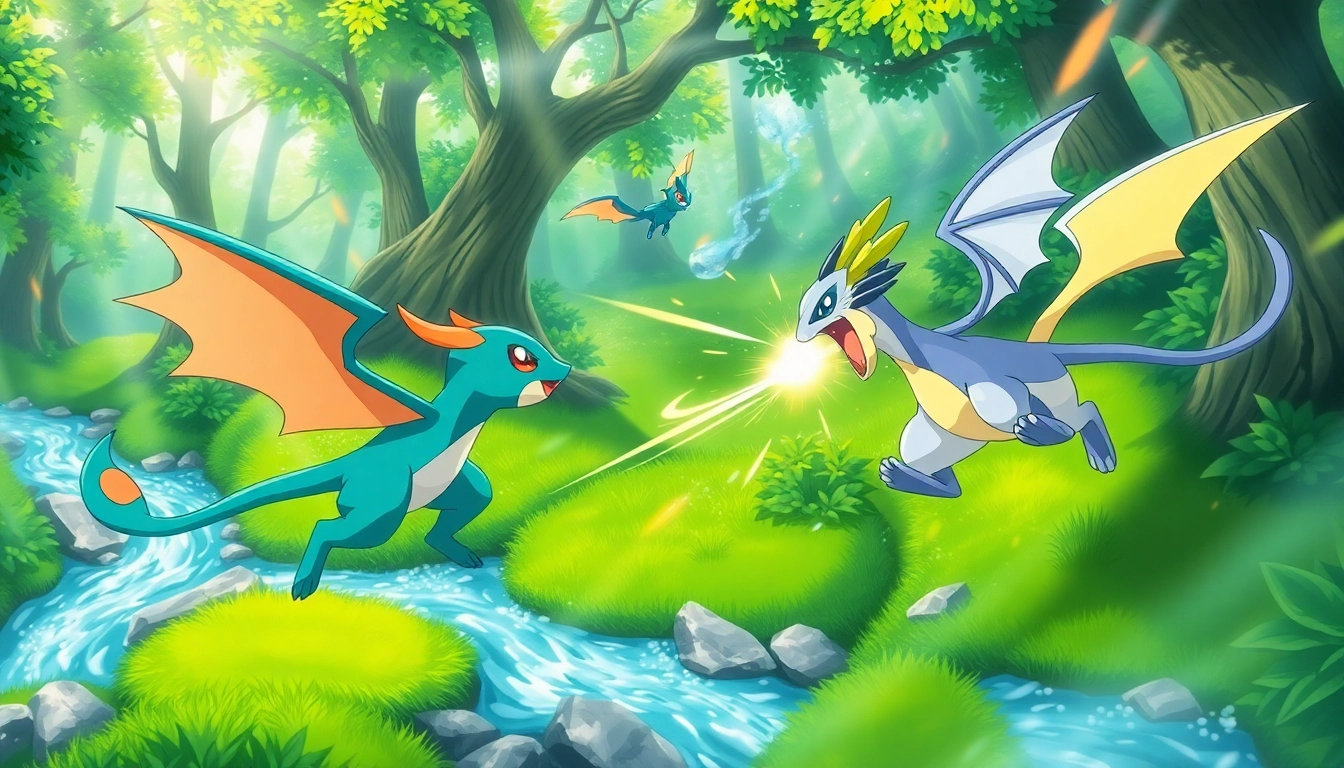Introduction to Pokémon
Pokémon has evolved into a global phenomenon, captivating audiences of all ages with its rich tapestry of games, trading cards, animated series, and movies. It paints a fantastical world where trainers capture, train, and battle creatures known as pokemon. In this journey, we will explore what Pokémon is, its historical roots, and the cultural significance that has allowed it to thrive for decades.
What is Pokémon?
At its core, Pokémon is a media franchise created by Satoshi Tajiri and Ken Sugimori, launched in the late 1990s. The premise revolves around trainers capturing mystical creatures known as Pokémon and battling them against one another. The name Pokémon is derived from the English words “Pocket” and “Monsters.” To date, the franchise has expanded into a wide range of products, from video games and trading cards to animated series and feature films. Each edition introduces new Pokémon species, regions, and game mechanics, ensuring continual engagement from fans.
History of Pokémon
Pokémon’s journey began in 1996 with the release of Pokémon Red and Pokémon Green for the Game Boy in Japan. Succeeding titles quickly followed, and the brand gained explosive popularity. The core games have since been released in generations that introduce new Pokémon and gameplay mechanics. Over the years, the franchise expanded to include an animated television series that debuted in 1997, a trading card game that enhances the interactive experience of Pokémon collecting, and numerous movies that delve deeper into the Pokémon universe. This multifaceted approach allowed Pokémon to transcend simple gaming to become a vital part of global entertainment culture.
Key Elements of Pokémon Culture
There are several facets that define Pokémon culture. One pivotal element is the concept of friendship and camaraderie between trainers and their Pokémon. This theme resonates with the franchise’s core values, often promoting messages of teamwork, perseverance, and growth. Additionally, Pokémon introduced the idea of community through trading and battling, fostering networks of fans and trainers. Events like Pokémon Championships and community gatherings such as Pokémon GO Fest are testament to the vibrant ecosystem that Pokémon has created.
Understanding Pokémon Games
Pokémon games have evolved with technology, maintaining the franchise’s relevance over time. Each game introduces new mechanics, Pokémon, and regions, which keeps the content fresh and engaging for both new players and seasoned veterans.
Types of Pokémon Games
Pokémon games are categorized primarily into core series games, spin-off titles, and mobile adaptations. The core series games are typically released in pairs with minor variations, encouraging trading and community interaction. Titles like Pokémon Sword and Shield and Pokémon Scarlet and Violet exemplify this trend, adding new mechanics while preserving the essence of capturing and battling Pokémon. Spin-off titles, including Pokémon Mystery Dungeon and Pokémon Snap, offer alternative gameplay experiences. In recent years, mobile games like Pokémon GO have revolutionized how players interact with the Pokémon world, incorporating augmented reality to enhance user engagement.
Gameplay Mechanics of Pokémon Games
Pokémon games incorporate various gameplay mechanics that form the backbone of the series. Capture mechanics allow players to encounter Pokémon in the wild and employ strategies to catch them. Battle mechanics involve turn-based combat, where trainers use their Pokémon’s unique abilities to win against opponents. Evolution, an iconic feature of Pokémon gameplay, allows creatures to transform into more powerful forms, enriching the strategy involved in training Pokémon. These fundamental mechanics are combined with extensive world-building elements, such as exploration, quests, and various Pokémon types, which contribute to an immersive experience.
Popular Pokémon Games to Play
To understand the landscape of Pokémon games, it’s essential to highlight some iconic titles. The Pokémon Red and Blue versions marked the inception of the franchise. The heartwarming stories and challenges of Pokémon Gold and Silver introduced a new generation of Pokémon and features like breeding. Pokémon Ruby and Sapphire further evolved gameplay and graphics, while Pokémon Diamond and Pearl were groundbreaking with their online connectivity. In recent years, Pokémon Legends: Arceus introduced a unique open-world experience that revitalized the series, proving that innovation continues to be a critical aspect of Pokémon games.
Pokémon Characters and Their Roles
Characters in Pokémon are varied and richly developed, from trainers to the Pokémon themselves. Each character contributes to the intricate narratives that players experience throughout the games and media.
Main Pokémon Characters
Training iconic characters such as Pikachu, the franchise’s mascot and a symbol of the series, is a rite of passage for Pokémon trainers. Major characters like Ash Ketchum serve as the protagonist in the animated series, embarking on journeys to become a Pokémon Master. Ash’s journey reflects the audience’s growth, showcasing values like bravery, friendship, and dedication. Other important figures include Gym Leaders, who represent challenges in each region, and rivals like Gary Oak, who push trainers to improve and evolve.
Legendary and Mythical Pokémon
Legendary and Mythical Pokémon play critical roles in the lore of Pokémon. Characters such as Mewtwo, Rayquaza, and Arceus embody the franchise’s mythology, often tied to themes of creation and destruction. These Pokémon typically possess extraordinary abilities and are often difficult, if not impossible, to capture within the main games. They are vital to the overarching narratives, often tied to the lore of the Pokémon universe. Their stories offer depth and intrigue, encouraging players to explore beyond traditional gameplay mechanics.
Character Development in Pokémon
Character development in Pokémon is evident in the progression of trainers and their Pokémon. Players witness their Pokémon evolve, both in gameplay mechanics and narrative journeys. For characters like Ash, growth is reflected not only in the Pokémon he trains but also in his maturity and understanding of friendships and rivalries. Side characters, including allies and rivals, contribute to a dynamic ecosystem that engages players and evolves with the storyline, encouraging investment in the Pokémon journey.
Engaging with the Pokémon Community
The Pokémon community is vast and active, offering numerous avenues for fans to connect, compete, and collaborate.
Pokémon Events and Competitions
Fans can participate in various Pokémon events and competitions, both locally and globally. Pokémon Championships allow trainers to showcase their skills in competitive battles, creating a thrilling atmosphere filled with strategy and excitement. Additionally, community events such as the Pokémon World Championships and online tournaments foster competitive spirit and facilitate connections among trainers from diverse backgrounds. These events highlight not only competitive gameplay but also showcase how passionate the Pokémon fanbase is about their favorite franchise.
Online Communities and Forums
The internet has birthed numerous platforms for Pokémon fans to connect, share strategies, artwork, and discussions about the franchise. Websites like Reddit and dedicated fan forums allow users to share their experiences, tips, and knowledge about the many aspects of Pokémon, including game mechanics and trading cards. Social media also plays a crucial role in keeping the community engaged, as fans share updates, theories, and artwork, further enhancing the collaborative and passionate nature of the Pokémon community.
Supporting Pokémon Creators
Supporting creators within the Pokémon community has ramifications for the wider ecosystem. Artists creating fan art, musicians composing Pokémon-inspired tunes, and writers producing fan fiction enhance the cultural tapestry of Pokémon. Engaging with these creations by sharing, promoting, or even contributing fosters a thriving environment where creativity and appreciation for the franchise can flourish. The synergy created among fans and creators exemplifies the spirit of collaboration that the Pokémon community embodies.
Future of Pokémon
The future of Pokémon is poised to be as remarkable as its past, with continued innovations and expansions that promise to engage a new generation of fans.
Innovations in Pokémon Games
As technology continues to advance, the potential for innovation in Pokémon games grows exponentially. Developers are exploring newer genres, gameplay mechanics, and immersive experiences such as virtual reality and augmented reality formats. Technology like cloud gaming and enhanced graphics can provide richer and more interactive gameplay experiences, further immersing players in the Pokémon world. These innovations will likely reshape how players interact with the franchise in the coming years, keeping Pokémon fresh and exciting.
Evolution of Pokémon in Media
Pokémon’s presence in media has also expanded beyond traditional games and cartoons. The rise of digital platforms has opened avenues for interactive experiences, such as streaming content and mobile-centric games that utilize geolocation. As audience consumption habits evolve, Pokémon must adapt to meet viewer expectations, incorporating new storytelling techniques and engaging formats. This evolution ensures that Pokémon remains relevant and retains its large, diverse fanbase.
Anticipated Pokémon Releases
With a dedicated fanbase eagerly awaiting new content, the anticipation for future Pokémon releases only heightens. Announcements of upcoming games, expansions, or anniversaries draw significant attention and conversation among fans. As the franchise adapts and expands, it will likely introduce new Pokémon, regions, and gameplay experiences that embody the evolving nature of the series while appealing to both nostalgic fans and newcomers alike.

